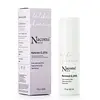What's inside
What's inside
 Key Ingredients
Key Ingredients

 Benefits
Benefits

 Concerns
Concerns

 Ingredients Side-by-side
Ingredients Side-by-side

Water
Skin ConditioningCaprylic/Capric Triglyceride
MaskingPropylene Glycol
HumectantPolyglyceryl-6 Stearate
EmollientGlycereth-26
HumectantGlycerin
HumectantPhenoxyethanol
PreservativeCetearyl Alcohol
EmollientPolysorbate 60
EmulsifyingCaprylyl Glycol
EmollientPolyglyceryl-6 Behenate
Emulsion StabilisingPoloxamer 235
EmulsifyingTetrasodium Glutamate Diacetate
Carbomer
Emulsion StabilisingXanthan Gum
EmulsifyingCitric Acid
BufferingRetinol
Skin ConditioningSodium Hyaluronate
HumectantTocopheryl Acetate
AntioxidantPolysorbate 20
EmulsifyingSodium Ascorbate
AntioxidantSodium Hydroxide
BufferingEpigallocatechin Gallate
AntioxidantBHT
AntioxidantDisodium EDTA
BHA
AntioxidantWater, Caprylic/Capric Triglyceride, Propylene Glycol, Polyglyceryl-6 Stearate, Glycereth-26, Glycerin, Phenoxyethanol, Cetearyl Alcohol, Polysorbate 60, Caprylyl Glycol, Polyglyceryl-6 Behenate, Poloxamer 235, Tetrasodium Glutamate Diacetate, Carbomer, Xanthan Gum, Citric Acid, Retinol, Sodium Hyaluronate, Tocopheryl Acetate, Polysorbate 20, Sodium Ascorbate, Sodium Hydroxide, Epigallocatechin Gallate, BHT, Disodium EDTA, BHA
Water
Skin ConditioningGlycerin
HumectantCetyl Alcohol
EmollientPanthenol
Skin ConditioningCetearyl Alcohol
EmollientGlyceryl Stearate
EmollientCoco-Caprylate/Caprate
EmollientStearic Acid
CleansingGlycine Soja Oil
EmollientRetinol
Skin ConditioningHydrolyzed Glycosaminoglycans
HumectantSodium Hyaluronate
HumectantCitrus Aurantium Amara Flower Extract
RefreshingJasminum Officinale Flower Extract
MaskingLavandula Angustifolia Flower Extract
CleansingPaeonia Officinalis Flower Extract
TonicPrunus Serrulata Flower Extract
Skin ConditioningSambucus Nigra Flower Extract
RefreshingHyaluronic Acid
HumectantHydrolyzed Hyaluronic Acid
HumectantSodium Hyaluronate Crosspolymer
HumectantRosa Damascena Flower Oil
MaskingHelianthus Annuus Seed Oil
EmollientRaspberry Ketone
MaskingTocopheryl Acetate
AntioxidantBenzyl Alcohol
PerfumingSodium Lauroyl Glutamate
Polysorbate 20
EmulsifyingPropanediol
SolventDehydroacetic Acid
PreservativeBenzyl Glycol
SolventEthylhexylglycerin
Skin ConditioningWater, Glycerin, Cetyl Alcohol, Panthenol, Cetearyl Alcohol, Glyceryl Stearate, Coco-Caprylate/Caprate, Stearic Acid, Glycine Soja Oil, Retinol, Hydrolyzed Glycosaminoglycans, Sodium Hyaluronate, Citrus Aurantium Amara Flower Extract, Jasminum Officinale Flower Extract, Lavandula Angustifolia Flower Extract, Paeonia Officinalis Flower Extract, Prunus Serrulata Flower Extract, Sambucus Nigra Flower Extract, Hyaluronic Acid, Hydrolyzed Hyaluronic Acid, Sodium Hyaluronate Crosspolymer, Rosa Damascena Flower Oil, Helianthus Annuus Seed Oil, Raspberry Ketone, Tocopheryl Acetate, Benzyl Alcohol, Sodium Lauroyl Glutamate, Polysorbate 20, Propanediol, Dehydroacetic Acid, Benzyl Glycol, Ethylhexylglycerin
Ingredients Explained
These ingredients are found in both products.
Ingredients higher up in an ingredient list are typically present in a larger amount.
Cetearyl alcohol is a mixture of two fatty alcohols: cetyl alcohol and stearyl alcohol. It is mainly used as an emulsifier. Emulsifiers help prevent the separation of oils and products. Due to its composition, it can also be used to thicken a product or help create foam.
Cetearyl alcohol is an emollient. Emollients help soothe and hydrate the skin by trapping moisture.
Studies show Cetearyl alcohol is non-toxic and non-irritating. The FDA allows products labeled "alcohol-free" to have fatty alcohols.
This ingredient is usually derived from plant oils such as palm, vegetable, or coconut oils. There is debate on whether this ingredient will cause acne.
Due to the fatty acid base, this ingredient may not be Malassezia folliculitis safe.
Learn more about Cetearyl AlcoholGlycerin is already naturally found in your skin. It helps moisturize and protect your skin.
A study from 2016 found glycerin to be more effective as a humectant than AHAs and hyaluronic acid.
As a humectant, it helps the skin stay hydrated by pulling moisture to your skin. The low molecular weight of glycerin allows it to pull moisture into the deeper layers of your skin.
Hydrated skin improves your skin barrier; Your skin barrier helps protect against irritants and bacteria.
Glycerin has also been found to have antimicrobial and antiviral properties. Due to these properties, glycerin is often used in wound and burn treatments.
In cosmetics, glycerin is usually derived from plants such as soybean or palm. However, it can also be sourced from animals, such as tallow or animal fat.
This ingredient is organic, colorless, odorless, and non-toxic.
Glycerin is the name for this ingredient in American English. British English uses Glycerol/Glycerine.
Learn more about GlycerinPolysorbate 20 is made by combining ethoxylation of sorbitan, ethylene oxide, and lauric acid. It is a mild cleansing agent, surfactant, and emulsifier.
As a surfactant, it helps collect dirt and oils for washing. Emulsifiers prevent oils and water from separating.
Polysorbate 20 also adds scent to a product. Since it is made using sorbitol, it has a sweet scent. Sorbitol can also be found in fruits such as apples and peaches.
The lauric acid used to create Polysorbate 20 is often derived from coconuts.
Polysorbate 20 may not be fungal acne safe.
Learn more about Polysorbate 20Retinol is a gold-standard ingredient for anti-aging. It is a form of Vitamin A and belongs to the class of retinoids that also includes tretinoin.
Why is retinol famous?
It has the most scientific studies backing up its skin benefits out of all the non-prescription ingredients.
Retinol is proven to:
This is why retinol is effective at removing wrinkles, fading dark spots, treating acne, and reducing the appearance of pores.
Studies show retinol is less effective when exposed to UV. Be sure to look for appropriate packaging to keep your retinol potent (similar to Vitamin C).
Using retinol or any retinoids will increase sun-sensitivity in the first few months. Though studies show retinoids increase your skin's natural SPF with continuous use, it is best to always wear sunscreen and sun-protection.
We recommend speaking with a medical professional about using this ingredient during pregnancy.
Retinol may cause irritation in some people, so be sure to patch test. Experts recommend 'ramping up' retinol use: start using this ingredient once a week and work up to using it daily.
Read about Tretinoin
Learn more about RetinolSodium Hyaluronate is hyaluronic acid's salt form. It is commonly derived from the sodium salt of hyaluronic acid.
Like hyaluronic acid, it is great at holding water and acts as a humectant. This makes it a great skin hydrating ingredient.
Sodium Hyaluronate is naturally occurring in our bodies and is mostly found in eye fluid and joints.
These are some other common types of Hyaluronic Acid:
Learn more about Sodium HyaluronateTocopheryl Acetate is AKA Vitamin E. It is an antioxidant and protects your skin from free radicals. Free radicals damage the skin by breaking down collagen.
One study found using Tocopheryl Acetate with Vitamin C decreased the number of sunburned cells.
Tocopheryl Acetate is commonly found in both skincare and dietary supplements.
Learn more about Tocopheryl AcetateWater. It's the most common cosmetic ingredient of all. You'll usually see it at the top of ingredient lists, meaning that it makes up the largest part of the product.
So why is it so popular? Water most often acts as a solvent - this means that it helps dissolve other ingredients into the formulation.
You'll also recognize water as that liquid we all need to stay alive. If you see this, drink a glass of water. Stay hydrated!
Learn more about Water